Terraplane
| Terraplane | |
|---|---|
.jpg) | |
| Overview | |
| Manufacturer | Hudson Motor Car Company |
| Production | 1932–1938 |
| Layout | FR layout |
The Terraplane was a car brand and model built by the Hudson Motor Car Company of Detroit, Michigan, between 1932 and 1938. In its maiden year, the car was branded as the Essex-Terraplane; in 1934 the car became simply the Terraplane. They were inexpensive, yet powerful vehicles that were used in both town and country, as both cars and trucks bore the Terraplane name.
.jpg)

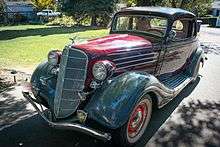
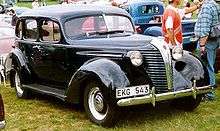
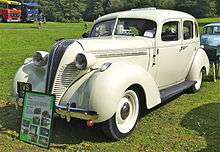
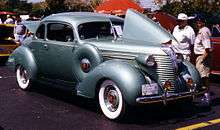
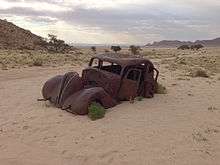
Changing marketplace
Hudson had manufactured the inexpensive Essex from 1919 as a lower-priced vehicle line; the company merged Essex into itself in 1922. The Essex is generally credited with helping to make the fully enclosed automobile an affordable model for inexpensive automobiles. The low-priced closed model Essex coach "had promoted the sensational recovery of Hudson" as an automaker in 1922.[1]
Declining sales of the Essex, combined with the growing pressure from the effects of the Great Depression forced Hudson to replace the Essex with a re-designed automobile with a lower manufacturing cost and selling price. Roy D. Chapin decided to repeat the successful strategy in 1932 by producing "a very light car in the bottom price class, a vehicle which would combine style, comfort, and reliability".[1] Although it was daring to launch a car during the Great Depression, Chapin was convinced that the Terraplane name would have "great public appeal" as it also linked with the public interest in aviation that was so prevalent at that time.[1]
The Terraplane contributed greatly to Hudson Motor's sales during the Depression 1930s. Sales of the Terraplane outpaced Hudson vehicles in the late mid-1930s and it is said that Hudson management was not fond of that fact and that was partly why they chose to eliminate the car as a make. One unique feature was "Duo-Automatic" brakes.[2] Terraplanes had two brake systems—hydraulic and mechanical. Should the hydraulic brakes fail (i.e. the brake line had a leak in it), the mechanical brakes would be used to stop the car.[3]
The most memorable sales slogan of the Terraplane years came from 1933: "On the sea that's aquaplaning, in the air that's aeroplaning, but on the land, in the traffic, on the hills, hot diggity dog, THAT'S TERRAPLANING".[4][5]
1932
The new Essex-Terraplane was launched on July 21, 1932, "with [such] sensational vigor" that "accounts of the affair appeared in newspapers throughout the United States."[1] The special event included over 2,000 dealers who came from 40 states to Detroit, Michigan. Hudson also had famous aviator Amelia Earhart helping to introduce the first Essex-Terraplane.[6] It was a small, but very powerful, car with a steel frame, built to exacting standards, which is probably why Orville Wright purchased one of the first Essex-Terraplanes for himself.[7] The 1932 model bore a slight resemblance to its Essex predecessors. The 1932 and 1933 models still had the name Essex-Terraplane on the radiator ornament.
In 1932, only the Model K on the 106-inch (2,692 mm) wheelbase with a 193 cu in (3.2 L) 6-cylinder engine was available.
1933
The Essex-Terraplanes were available in all the common U.S. automobile body styles. For 1933 offerings were expanded. The Model K was retained. A Model KU 6-cylinder on 113 in (2,870 mm) wheelbase was added. Also a Model KT with a244 cu in (4.0 L) straight-8-cylinder was offered on the 113-inch wheelbase. There were "Standard" and "Deluxe" trim levels for the KU and KT. A limited selection of light commercial vehicles were offered starting in 1933.
Only the 1933 Essex-Terraplanes were made with an optional eight-cylinder engine. The Hudson had the identical basic engine, but with earlier style updraft carburetor carried over, and a displacement of 254 cu in (4.2 L) due to a larger cylinder bore than the Essex-Terraplane Eight. The Terraplane Eight engines featured more efficient downdraft carburetion. Both engines had the same crankshaft and stroke.
The 1933 Essex-Terraplane 8-cylinder cars were believed to have the highest horsepower-to-weight ratio of any production automobiles in the world, and were favored by several gangsters of the day, particularly John Dillinger, Baby Face Nelson, and John Paul Chase, for their lightness, acceleration, handling, and discreet appearance.
The Essex-Terraplane Eight was distinguished by having vent doors on the hood as opposed to all six-cylinder versions that had stamped hood louvers. A 1933 Terraplane 8 convertible coupe set a record for the race to the summit of Mount Washington that remained unbroken for over twenty years. Essex-Terraplanes participated in innumerable record events around the United States, and some others around the world setting dozens of records at many venues. Their particular strength was in hillclimbs. Period road tests showed 0-60mph in 14.4 seconds, and 10-60mph in top gear in 18 seconds.
1934-7
For 1934 the word "Essex" was dropped and the car became the Terraplane. The cars were slightly heavier and rarely joined competitive events, particularly as they now lacked the eight-cylinder powerplant. The name Terraplane remained constant through the 1937 model year. By 1936, Terraplane commercial cars were produced in larger numbers.
1938
In 1938, knowing they were going to drop the Terraplane, Hudson management chose to phase out the Terraplane name similarly to how it had been introduced, and the 1938 cars were named Hudson-Terraplanes. Concurrently for the 1938 model year, Hudson offered a Model 112 which was virtually indistinguishable in equipment from the Hudson Terraplane, but on a shorter 112 in (2,845 mm) wheelbase and with a smaller engine. The Terraplane did not have an ammeter or an oil pressure gauge.[8]
International markets
Hudson vehicles were assembled in other countries under license. The British sounding names of "Hudson" and "Essex" had made them popular in countries of the Commonwealth, and thus Terraplanes also were built outside the U.S. in England and Australia in low volume. Australian law made it impractical to import a fully assembled car and thus main bodies were built by local craftsman at firms such as Ruskin Motor Bodies Ltd. and General Motors-Holden's Ltd, both of Melbourne, Victoria. In a few cases these bodies included styles not available in the U.S. market such as tourers (U.S. equivalent phaeton) and coupe utilities (the Australian car-based pickup truck).
British Railton cars
.jpg)
The Terraplane 8-cylinder chassis and engine was also used in the British Railton automobiles for their initial production year 1933.
The 1934 Light Sports Tourer used a lightweight open four-seater body and mildly modified engine. It achieved 0-60mph in 8.8 seconds, a sensational time pre-war, and a top speed of 107mph on the 3.3:1 rear axle. The engine was so flexible that it could be driven in circles on full lock in top gear without snatching.
Numerous coach builders constructed Railton bodies for the Terraplane and later Hudson chassis. Railton cars continued to be built on 1934 Hudson 8, and later Hudson 6- and 8-cylinder chassis through 1939. The company was bought by Hudson in 1939.
See also
- Hudson Utility Coupe
- Terraplane Blues, a 1936 blues song recorded by Robert Johnson
Notes
- 1 2 3 4 Long, John Cuthbert; Hyde, Charles K. (2004). Roy D. Chapin: the man behind the Hudson Motor Car Company. Wayne State University Press. p. 225. ISBN 978-0-8143-3184-2. Retrieved 12 February 2014.
- ↑ "Hudson 1936 - How What Why". Oldcarbrochures.com. Retrieved 12 February 2014.
- ↑ "Hudson 1936 - How What Why". Oldcarbrochures.com. Retrieved 12 February 2014.
- ↑ Hedgbeth, Llewellyn. "Auto-Biography: Hudson Terraplane". secondchancegarage.com. Retrieved 12 February 2014.
- ↑ Piersol, Richard (14 June 2012). "Fun cars on a roll in Lincoln". Lincoln Journal Star. Retrieved 12 February 2014.
- ↑ Hyde, Charles K. (2009). Storied Independent Automakers. Wayne State University Press. ISBN 978-0-8143-3446-1.
- ↑ "Letter, Amelia Earhart to Orville Wright, August 6, 1932". The Library of Congress, The Wilbur and Orville Wright Papers. Retrieved 12 February 2014.
- ↑ "Hudson 1935 Terraplane Special Owners Manual". Oldcarbrochures.com. Retrieved 12 February 2014.
References
- "Terraplane: Flying by Land". Automobile Quarterly. 39 (1): 64–79. May 1999.
External links
| Wikimedia Commons has media related to Terraplane vehicles. |
- Terraplane history at secondchancegarage.com
- Hudson-Essex-Terraplane Club
- Essex Terraplane Six 1933 Owner's Manual of Information at Project Gutenberg